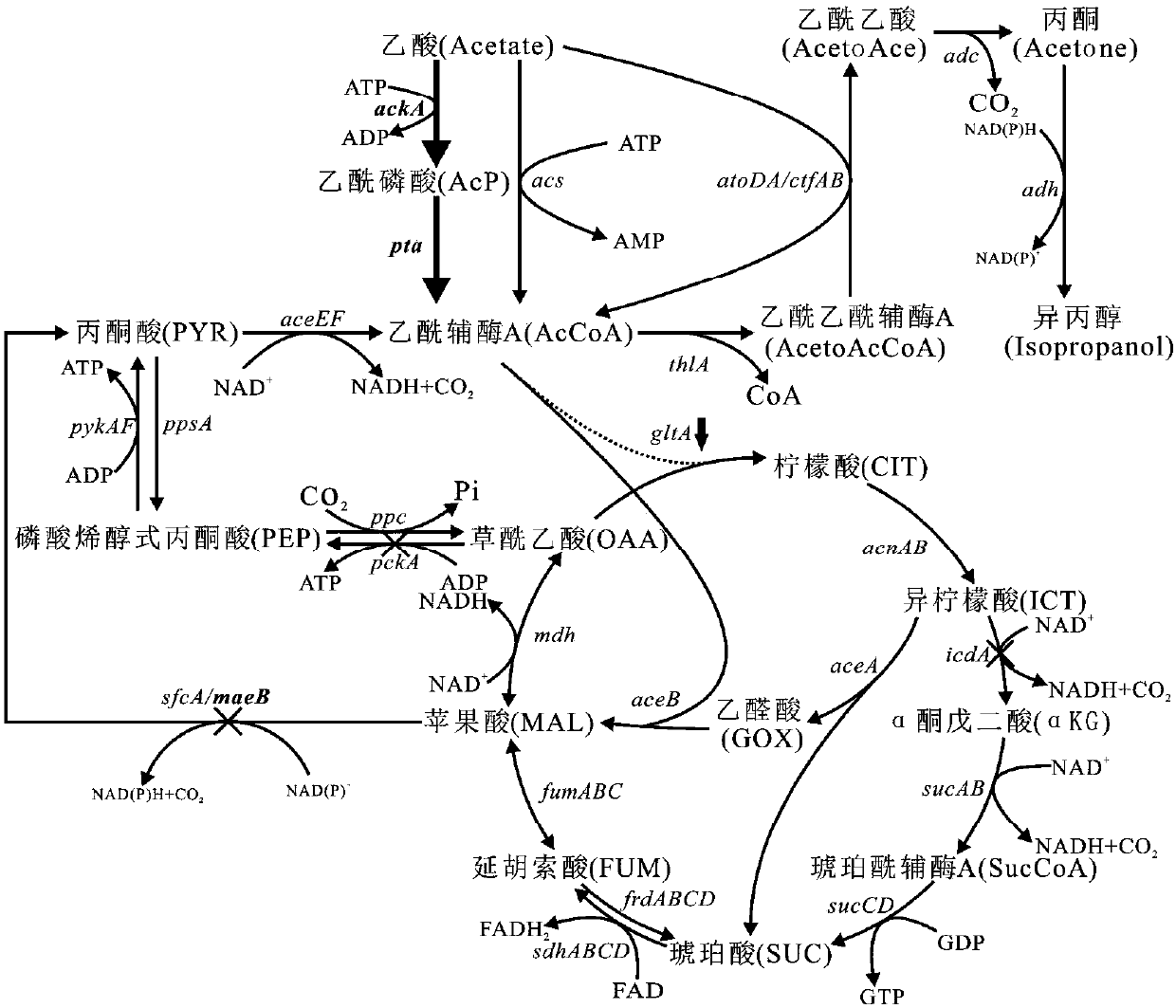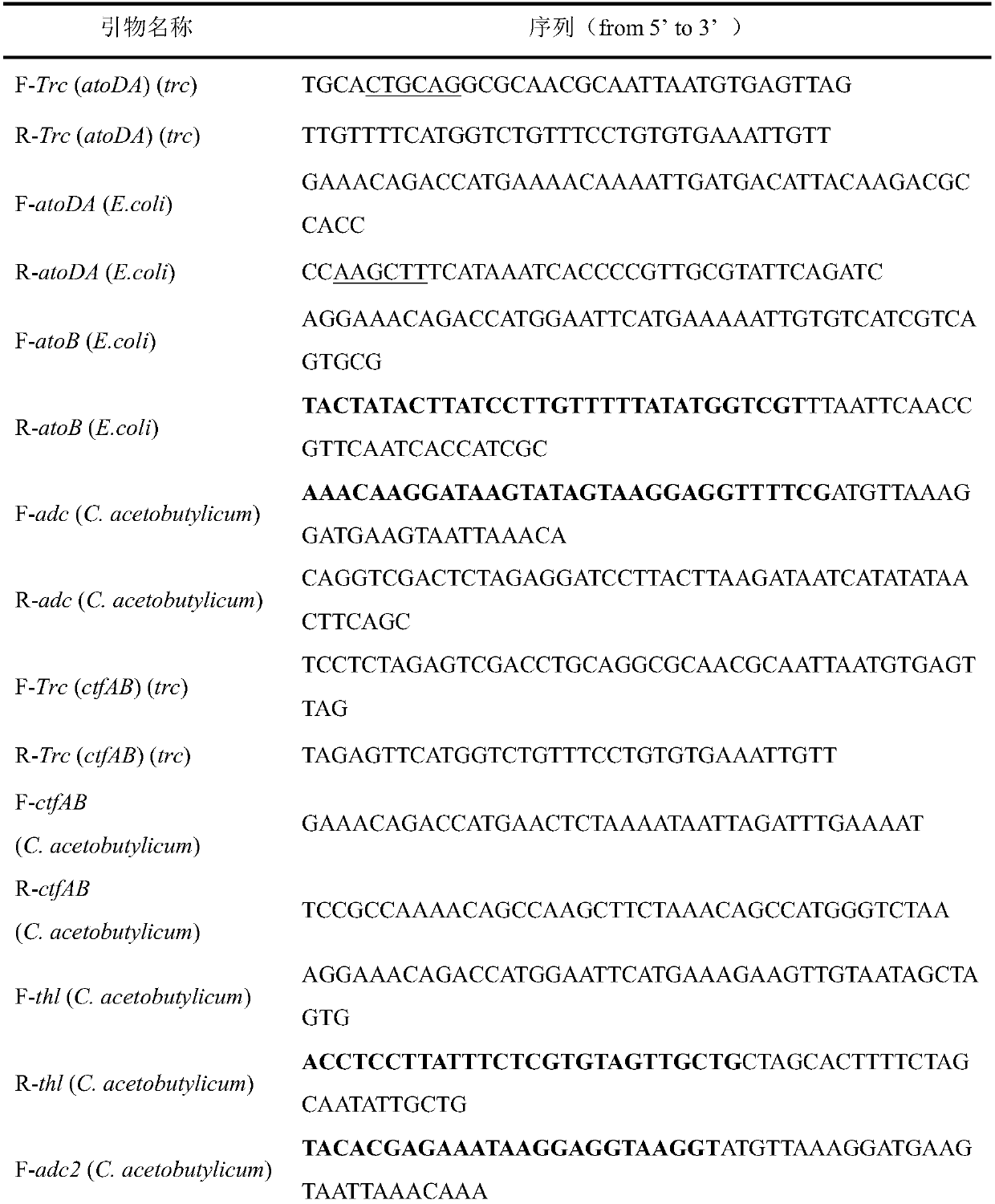Construction method and application of metabolic engineering escherichia coli strain for producing acetone or isopropanol by virtue of acetic acid
A technology of Escherichia coli and metabolic engineering, which is applied in the field of bioengineering to achieve the effect of increasing production and improving absorption rate
- Summary
- Abstract
- Description
- Claims
- Application Information
AI Technical Summary
Problems solved by technology
Method used
Image
Examples
Embodiment 1
[0037] Embodiment 1. The construction of acetone production pathway to obtain the bacterial strain of acetone production
[0038] Using the pTrc99a plasmid as a vector, a heterologous expression pathway for acetone production was constructed by overexpressing key enzymes from the acetone production pathway in E.coli or C.acetobutylicum. The enzymes that synthesize acetone from acetyl-CoA are thiolase, CoA transferase, and acetoacetate decarboxylase, and CoA transferase is coded by two different genes for its different subunits. However, there is no gene encoding acetoacetate decarboxylase in E.coli. Three different recombinant plasmids were obtained by combining and expressing the above four genes from E.coli and C.acetobutylicum in pTrc99a. They are pTrc99a-thl-RBS-adc-Trc-ctfAB (the above genes are all from C. acetobutylicum), pTrc99a-thl-RBS-adc-Trc-atoDA (thl, adc are from C. acetobutylicum, atoDA is from E. coli), pTrc99a-atoB-RBS-adc-Trc-atoDA (adc comes from C.acetobu...
Embodiment 2
[0049] Example 2. Enhancing the transport pathway of acetic acid
[0050] Replace the promoter of the gene (ack, pta) of the acetyl-CoA pathway of acetic acid production by Red recombination. In E.coli, ack and pta share a promoter, and the constitutive expression through the mutation of the trc promoter is stronger The promoter of the gene replaces the ack and pta promoters on the genome to enhance its expression. The strain with successful promoter replacement was named HY01, and the specific operation of promoter replacement was as follows:
[0051] First, primers were designed to amplify the Kana fragment with the target promoter, and the template plasmid was digested with Dpn I to remove methylation. The plasmid pKD46 was introduced into the host bacteria through calcium transformation, and recombinants were screened with ampicillin. Recombinant bacteria introduced with pKD46 were cultured at 30°C to OD 600 At about 0.3, L-arabinose was added for induction for 1 hour, ...
Embodiment 3
[0053] Embodiment 3. Knock out gene to further improve the output and yield of acetone
[0054] Since the gene expression of the gluconeogenesis pathway is up-regulated in the medium with acetic acid as the carbon source, excess carbon source flows to the gluconeogenesis pathway. Therefore, the red recombination method was used to knock out the genes maeB, pckA, icdA, adhE and sfcA. The strain with maeB knockout on the basis of HY 01 was named HY 02, and the strain with pckA knockout on the basis of HY 02 was named HY 03. The specific operation of gene knockout is as follows:
[0055] For the knockout of the gene maeB, use the E.coli MG1655 single-deletion maeB strain preserved in our laboratory as a template, first design primers (primer sequences are shown in the table below), and clone a DNA fragment of about 1700bp with kana resistance by PCR . The fragment was transferred into the electroporation-competent host bacteria by electroporation. The preparation of the electr...
PUM
 Login to View More
Login to View More Abstract
Description
Claims
Application Information
 Login to View More
Login to View More - R&D
- Intellectual Property
- Life Sciences
- Materials
- Tech Scout
- Unparalleled Data Quality
- Higher Quality Content
- 60% Fewer Hallucinations
Browse by: Latest US Patents, China's latest patents, Technical Efficacy Thesaurus, Application Domain, Technology Topic, Popular Technical Reports.
© 2025 PatSnap. All rights reserved.Legal|Privacy policy|Modern Slavery Act Transparency Statement|Sitemap|About US| Contact US: help@patsnap.com



